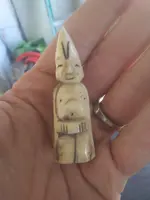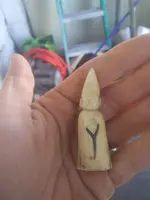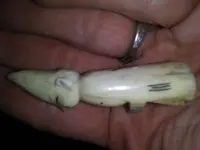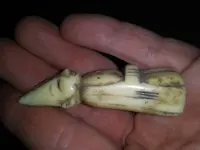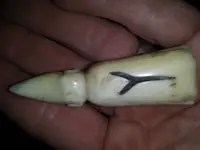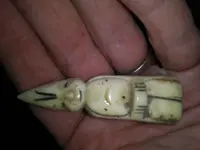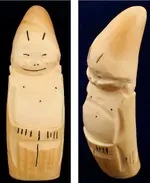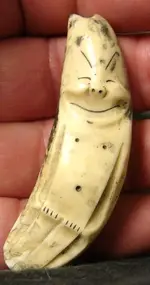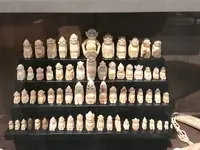You are using an out of date browser. It may not display this or other websites correctly.
You should upgrade or use an alternative browser.
You should upgrade or use an alternative browser.
What is this?
- Thread starter Tishtash
- Start date
Tishtash
Greenie
- Joined
- Jan 23, 2020
- Messages
- 14
- Reaction score
- 14
- Golden Thread
- 0
- Primary Interest:
- All Treasure Hunting
- #3
Thread Owner
A very Brady bad luck charm? What do you mean? I can't tell if it's bone or ivory. It was buried in the edge of the driveway saw the point of the hat sticking out of the dirt so I dug it up
Last edited:
trdking
Gold Member
- Joined
- Feb 28, 2015
- Messages
- 5,139
- Reaction score
- 7,923
- Golden Thread
- 0
- Location
- Fullerton CA
- Detector(s) used
- Minelab CTX 3030
AT Pro
- Primary Interest:
- All Treasure Hunting
Im going Brady bad Karma.
CCDAMEEK
Sr. Member
- Joined
- Aug 5, 2019
- Messages
- 255
- Reaction score
- 668
- Golden Thread
- 0
- Location
- central Florida
- 🏆 Honorable Mentions:
- 1
- Detector(s) used
- Whites DFX 300;
Tesoro Tiger Shark;
Minelab CTX 3030
- Primary Interest:
- All Treasure Hunting
Heat a sewing needle with the flame from a lighter until it is red hot. Touch it to the bottom of the figure and gently try to push it into the bottom. If it goes in at all, it is a plastic of some kind. If the hot needle doesn't go into it or leave a mark, it is made of at the very least, bone, and could be ivory, but orientals made a lot of things like this out of animal or whale bone.
- Joined
- Aug 24, 2017
- Messages
- 21,195
- Reaction score
- 36,210
- Golden Thread
- 1
- Location
- SW Missouri/Oklahoma
- 🥇 Banner finds
- 1
- 🏆 Honorable Mentions:
- 2
- Detector(s) used
- Minelab CTX 3030; Minelab Equinox 800;
XP Deus 2
- Primary Interest:
- All Treasure Hunting
Nice!! Congrats!!
- Joined
- Mar 2, 2018
- Messages
- 7,351
- Reaction score
- 23,366
- Golden Thread
- 0
- Location
- Todds Point, IL
- Primary Interest:
- Metal Detecting
It's a netsuke, but it looks like a Klansman. Gary
- Joined
- Aug 19, 2014
- Messages
- 39,032
- Reaction score
- 143,862
- Golden Thread
- 0
- Location
- Tarpon Springs
- Detector(s) used
- JW 8X-ML X2-VP 585
- Primary Interest:
- All Treasure Hunting
It is IMO a little carved figure from Alaska... It is what appears to be Walrus Ivory.
Would bet on it.
It is called... "Inuit art"
Would bet on it.
It is called... "Inuit art"
- Joined
- Aug 19, 2014
- Messages
- 39,032
- Reaction score
- 143,862
- Golden Thread
- 0
- Location
- Tarpon Springs
- Detector(s) used
- JW 8X-ML X2-VP 585
- Primary Interest:
- All Treasure Hunting
- Joined
- Dec 23, 2019
- Messages
- 6,464
- Reaction score
- 20,535
- Golden Thread
- 0
- Location
- Surrey, UK
- Primary Interest:
- All Treasure Hunting
Although what you have may well be Inuit-carved (if it’s ivory rather than resin), it has nothing to do with their culture. It’s what’s known as a “Billiken”… an imagined figure claimed to have been seen in a dream by the American art teacher and illustrator Florence Pretz of Missouri. She patented the design on 6th October 1908, taking the name “Billiken” from Bliss Carman's 1896 poem “Mr. Moon: A Song Of The Little People.”
She then commercialized it, selling all manner of objects using the figurine design as a good luck totem via the Billiken Company of Chicago: chalkware figures, dolls, moneybanks, jewelllery, lucky tokens, postcards and other items. The chalkware figures were also later sold with a throne that carried the motto "The God Of Things As They Ought To Be" around the base.
To buy a Billiken was said to give the purchaser luck, but to receive one as a gift would be better luck. The concept became a worldwide craze for several years and then faded into obscurity, although Billiken has been adopted as the official ‘God’ of the ‘Church of Good Luck’.
In 1909, Billikens began appearing in the souvenir shops of Alaska after an Eskimo carver in Nome called Angokwazhuk loosely copied it in ivory, based on one that had been given to him by a merchant. By the 1960s it was ubiquitous in larger Alaskan cities like Anchorage, and heavily touristed areas. These souvenirs were often accompanied by a little printed card that contained a largely invented history of Billiken and what he represented.
Here’s a couple of examples. The earrings are from the 1950s and the standalone carving perhaps somewhat older, but no earlier than 1909.
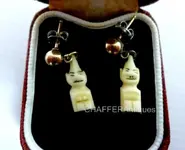
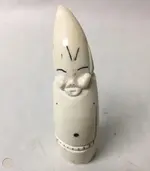
She then commercialized it, selling all manner of objects using the figurine design as a good luck totem via the Billiken Company of Chicago: chalkware figures, dolls, moneybanks, jewelllery, lucky tokens, postcards and other items. The chalkware figures were also later sold with a throne that carried the motto "The God Of Things As They Ought To Be" around the base.
To buy a Billiken was said to give the purchaser luck, but to receive one as a gift would be better luck. The concept became a worldwide craze for several years and then faded into obscurity, although Billiken has been adopted as the official ‘God’ of the ‘Church of Good Luck’.
In 1909, Billikens began appearing in the souvenir shops of Alaska after an Eskimo carver in Nome called Angokwazhuk loosely copied it in ivory, based on one that had been given to him by a merchant. By the 1960s it was ubiquitous in larger Alaskan cities like Anchorage, and heavily touristed areas. These souvenirs were often accompanied by a little printed card that contained a largely invented history of Billiken and what he represented.
Here’s a couple of examples. The earrings are from the 1950s and the standalone carving perhaps somewhat older, but no earlier than 1909.


Last edited:
G.I.B.
Gold Member
- Joined
- Feb 23, 2007
- Messages
- 7,187
- Reaction score
- 8,539
- Golden Thread
- 0
- Location
- North Central Florida
- 🏆 Honorable Mentions:
- 1
- Detector(s) used
- CTX 3030 / GTI 2500 / Infinium LS / Tesoro Sand Shark / 1 Garrett Pro-pointer / 1 Carrot / Vibra Probe 580 (out on loan) / Lesche M85 / Mark1 MOD1 EyeBall
- Primary Interest:
- Other
How about adding a general location of your find. It may help narrow things down a bit.
- Joined
- Aug 19, 2014
- Messages
- 39,032
- Reaction score
- 143,862
- Golden Thread
- 0
- Location
- Tarpon Springs
- Detector(s) used
- JW 8X-ML X2-VP 585
- Primary Interest:
- All Treasure Hunting
I found those online but can't find one that looks just like mine
That's because they are each hand made... no 2 alike so to speak... there are individuals who practice the craft... each with their own "style" or "take"... on a fiqure.
Follow ?
Like I said .. it is Walrus Ivory OR walrus bone... or bone from anything really.
If it is Ivory it will be "telltale"...
Post picture of bottom and I will tell you if possible to see.
- Joined
- Dec 23, 2019
- Messages
- 6,464
- Reaction score
- 20,535
- Golden Thread
- 0
- Location
- Surrey, UK
- Primary Interest:
- All Treasure Hunting
islamoradamark
Silver Member
- Joined
- Aug 26, 2016
- Messages
- 3,630
- Reaction score
- 3,993
- Golden Thread
- 0
- Primary Interest:
- All Treasure Hunting
oh wow I thought we were being invaded by the coneheads
Tishtash
Greenie
- Joined
- Jan 23, 2020
- Messages
- 14
- Reaction score
- 14
- Golden Thread
- 0
- Primary Interest:
- All Treasure Hunting
- #19
Thread Owner
That's because they are each hand made... no 2 alike so to speak... there are individuals who practice the craft... each with their own "style" or "take"... on a fiqure.
Follow ?
Like I said .. it is Walrus Ivory OR walrus bone... or bone from anything really.
If it is Ivory it will be "telltale"...
Post picture of bottom and I will tell you if possible to see.
I posted new up close pictures and pictures of the bottom also
- Joined
- Aug 19, 2014
- Messages
- 39,032
- Reaction score
- 143,862
- Golden Thread
- 0
- Location
- Tarpon Springs
- Detector(s) used
- JW 8X-ML X2-VP 585
- Primary Interest:
- All Treasure Hunting
I posted new up close pictures and pictures of the bottom also
Ahhh yes... I see them... most people just post a new post with them so I never looked at top of page... sorry.
Anyway...
Yes... IMO you have walrus ivory.
Age... unknown.
Just for your own knowledge you should take all the info contained herein and use "keywords" for searching this criteria online...
spend some time researching...
don't rely solely here for we cannot see the item in person... and you can

Similar threads
Users who are viewing this thread
Total: 1 (members: 0, guests: 1)
Latest Discussions
-
-
-
Naturallly Occuring Formation OR Manmade Treasure Marker/Sign?
- Latest: Crosse De Sign
-
-
-

